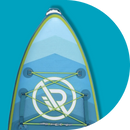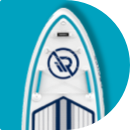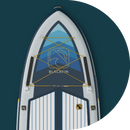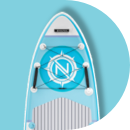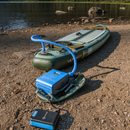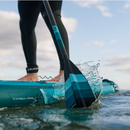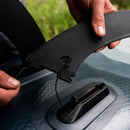A Beginner’s Guide on How to Choose a Paddle Board

If you’re on hunt for an exciting outdoor activity that combines fitness, relaxation, and adventure, look no further than Stand up Paddle Boarding. This water sport has been captivating outdoor enthusiasts for years and with good reason. But with so many brands, designs, and models available, learning how to choose a paddle board can be super overwhelming for beginners. Don’t worry, we’ll help you determine which board is best for you and your SUP style.
The essential factors to consider when buying your first stand up paddle board include weight and size, your skill level, how you’ll use your board, and quality. Let’s take a look at each in more detail.
Choose Paddle Boards Based on Features
Regarding tips on how to choose a paddle board, crucial features to consider are the weight, size, skill level, length, width, and type of paddle board, which are described in detail in the section below.

1. Weight and Size
Your height and weight are key factors in determining how to choose a stand up paddle board size that's best for you. A paddle board should support your weight and be stable enough for you to stand on it without feeling unsteady. A longer and wider paddle board can be ideal for taller or heavier paddlers. But note that the wider a paddle board is, the slower it is on the water.

It's also good to think about whether you will be alone on your board or if you plan to paddle with another rider, child, or additional cargo. These useful tips for buying a paddle board will help determine the weight capacity of the board you need. Our BLACKFIN boards, for example, offer the highest weight capacity of any SUPs on the market, perfect for those bringing along additional fishing or camping gear.
2. Skill Level
Your skill level and comfort will also bring you the most enjoyment on the water. As a beginner, you'll want to choose a stable board that is easy to balance. A wider board with more volume will provide better stability and make it easier to stand up and balance. As you progress, you can choose a narrower board with less volume for better speed and maneuverability.

One of our most stable paddle boards, the CRUISER features an extra-wide 33-34” base, broad tail, and additional stability features. It is perfect for beginners looking to feel steady and secure.
3. Length and Width
The length of a paddle board plays a pivotal role in picking its speed and maneuverability. Basically, there are 3 types of paddle boards based on length:
- Short board (under 10 feet): Ideal for surfing and kids, offering enhanced maneuverability. These boards typically have a planing hull design.
- Medium board (10 to 12 feet): This board is versatile for all-around use and SUP yoga. Most feature planing hulls are available in this range, although some displacement hulls are also available.
- Long board (12.6 feet and above): These are excellent for fast paddling and long-distance touring. The majority are displacement-hull SUPs, which provide increased speed and better tracking.
Another factor to consider regarding how to choose a paddle board is width, as it determines stability and versatility.

The three most common types are:
- Narrow board (up to 30 inches): Offers speed and maneuverability, favored by racers and surfers. Suitable for experienced paddlers.
- Medium (32 to 34 inches): Strikes a balance between stability and performance, accommodating various skill levels and activities.
- Wide board (more than 34 inches): This board provides superior stability and ample space for activities like SUP yoga or carrying gear. It is ideal for beginners and larger paddlers.
4. Paddle Board Construction
With a wide array of paddle board options available, it's useful to know about the different construction types that can help you make an informed decision that best suits your needs and preferences.

- Soft-top paddle board: These boards feature a durable, spongy EVA foam deck and rails, offering excellent durability and a forgiving surface. They are ideal for beginners, casual riders, and those who prioritize stability over performance. They are also great for pet activities or where frequent falls may occur.
- Inflatable paddle board: Made from high-density PVC with drop-stitch technology, inflatable SUPs (iSUPs) combine hard boards' rigidity and performance with soft-top boards' durability. They are highly portable when deflated and can be customized for various skill levels and activities.
- Hard paddle board: Constructed from a combination of EPS foam, fiberglass, carbon, and epoxy resin, these rigid boards are designed for optimal glide, tracking, and speed. While ideal for long-distance touring and riding waves, they are less forgiving, more prone to scratches and dents, and more challenging to transport. Recommended for experienced paddlers.
Choose Paddle Board Based on Intended Use
Paddle boards come in various shapes and sizes designed for different activities such as racing, touring, surfing, and even SUP yoga. Keep reading to learn how to choose a paddle board that is perfect for you.
- All around SUPs: Versatile boards designed for recreational paddling, ranging from 10'6" to 12' in length. They strike a balance between stability and maneuverability, suitable for various activities like casual paddling, yoga, and fishing.
- Yoga SUPs: Typically wider than standard all-around boards, these SUPs prioritize stability and balance. Their design, with a side-mounted handle and a wider deck, facilitates yoga practice while providing the benefits of core engagement on the water.
- Touring SUPs: Longer boards, generally 12' and above, are optimized for speed and efficiency over long distances. Their narrower shape and sleek design allow them to cut through the water smoothly, ideal for touring, racing, and training.
- Fishing SUPs: Designed with ample carrying capacity in mind, fishing SUPs range from 11' to 14' in length. Their size and stability accommodate the weight of fishing gear, allowing anglers to bring all their equipment on board.
- Surfing SUPs: Shorter boards, around 10'6" in length, are the go-to choice for paddle surfing. With their surf-style planing hull, side bite fins, and responsive maneuverability, they excel in catching waves and delivering an exhilarating surfing experience on a paddle board.
In addition to how you'll use it, think about where you'll use your board. Are you paddling locally? Or do you plan to travel with your SUP? If your paddle destination requires a plane ride or even a road trip, a board from our ULTRA™ Series may be the way to go! Ultra-compact by design, these incredibly lightweight boards pack into a streamlined backpack perfect for travel. Or, if you're a beginner and just looking for something more casual, check out our collection of non-ultra paddle boards!

Choose Paddle Boards Based On Their Quality
Originally, hard paddle boards were the only available choice for those looking to SUP. However, as technology has evolved, lighter-weight inflatable paddle boards have come to dominate the space, loved for their convenient portability. When deciding how to choose a paddle board, it's worth noting that when inflated, these boards are just as rigid, stiff, and durable as their predecessors. Some paddlers find it difficult to distinguish between a solid board and a quality inflatable!
When it comes to paddle board construction, a variety of materials are used, each offering distinct advantages and characteristics. Here's an overview of the most common materials:
- Plastic: Rotomolded plastic paddle boards are known for their durability and affordability, popular with recreational paddlers. However, they tend to be heavier and less performance-oriented than other materials.
- Foam: Soft-top paddle boards feature a foam core with a durable outer skin, providing a comfortable and forgiving surface. While stable, they may lack the rigidity and speed of harder constructions.
- Carbon fiber: Lightweight yet incredibly strong, carbon fiber paddle boards offer superior performance and responsiveness. Their construction typically features a foam core surrounded by carbon fiber layers, which are expensive but highly desired by advanced paddlers seeking top-notch performance.
- PVC and Polycarbonates: Almost all inflatable SUPs are made from tough, multi-layer PVC material using drop-stitch technology. This construction allows for portability without compromising rigidity when inflated, making it a versatile choice for various paddling activities.
- Wood: Wooden paddle boards, often with a hollow core, offer a unique and traditional appearance. While beautiful, they require more maintenance and can be less durable than other materials in certain conditions, which is suitable for specific enthusiasts.
With so many great boards available, narrowing down your choices can seem daunting. But think about what your ideal SUP session looks like. Where are you paddling, and what are the conditions? Are you solo or with a friend on board? Will you be bringing extra cargo along? These questions and your body type will help you determine the perfect board for you.

If you are completely new to the sport and testing whether paddle boarding is for you, we recommend starting with our affordable, entry-level NAUTICAL line to learn how to choose a stand up paddle board. These reliable boards deliver fun on the water without breaking the bank.
- For light to medium weight paddlers, we recommend choosing between NAUTICAL and ULTRA™.
- For medium to higher weight paddlers or those looking to bring extra cargo, we recommend choosing between iROCKER and BLACKFIN.
- For paddlers looking for the convenience of a lightweight board in a smaller package, select ULTRA™.
- For paddlers seeking a premium option with maximum versatility, speed, and stability no matter your skill level, select BLACKFIN.
The best news is you can never have too many paddle boards. So, as you grow more confident and progress your skills, you can take on new challenges with different sizes and shapes of boards.

Choose iROCKER Stand Up Paddle Board!
In conclusion, getting the right insights on how to choose a paddle board is essential for an enjoyable and safe experience on the water. We hope that buying a paddle board guide above has given you useful tips for deciding which one is perfect for you.
You can visit our website and explore our extensive collection of high-quality inflatable paddle boards designed to meet the needs of paddlers of all levels. Our knowledgeable team is ready to guide you towards the perfect board that will elevate your paddling adventures!
